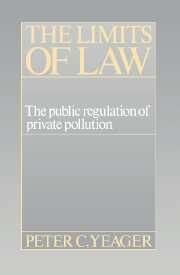Book contents
- Frontmatter
- Contents
- Preface
- Acknowledgments
- 1 The social production of business offenses
- 2 Bringing the law back in: an integrated approach
- 3 The politics of water: pollution policies to 1970
- 4 Contradiction and change: environmental consciousness and the mobilization of law
- 5 Legislating clean water: changing conceptions of environmental rights
- 6 Controls and constraints: from law to regulation
- 7 Enforcement: the social production of environmental offenses
- 8 Ecology, economy, and the evolution of limits
- Bibliography
- Index
2 - Bringing the law back in: an integrated approach
Published online by Cambridge University Press: 23 May 2010
- Frontmatter
- Contents
- Preface
- Acknowledgments
- 1 The social production of business offenses
- 2 Bringing the law back in: an integrated approach
- 3 The politics of water: pollution policies to 1970
- 4 Contradiction and change: environmental consciousness and the mobilization of law
- 5 Legislating clean water: changing conceptions of environmental rights
- 6 Controls and constraints: from law to regulation
- 7 Enforcement: the social production of environmental offenses
- 8 Ecology, economy, and the evolution of limits
- Bibliography
- Index
Summary
Like all social theory, our perspectives on law are firmly rooted in human history. It was much easier, for example, to view law as a broadly consensual, dispassionate protector of rights and arbitrator of disputes when society was characterized by a relatively decentralized market economy populated by small, competing entrepreneurs. The state's role then could be seen as simply that of ensuring the conditions under which the private entrepreneurial spirit could work its magic: creating societal progress from the competitive individual pursuit of wealth. In the main, this role meant state protection of property and contract rights and refereeing of disagreements over them.
But during the past century, such a view of law became less tenable. Increasingly, the state became involved in the fundamental workings of the economy and was forced to stake out positions in the growing conflicts between capital and labor and among sectors of capital (see, e.g., Kolko, 1963; Inverarity, Lauderdale, and Feld, 1983: ch. 7). The state also necessarily developed a major role in the politics of distribution and redistribution, influencing the flow of capital and “life chances,” and played an increasingly important part as purchaser of goods and producer of jobs and services. The workings of state and economy became ever more interwoven, while critical decision making in both sectors became centralized in large, powerful bureaucracies.
- Type
- Chapter
- Information
- The Limits of LawThe Public Regulation of Private Pollution, pp. 17 - 50Publisher: Cambridge University PressPrint publication year: 1991



